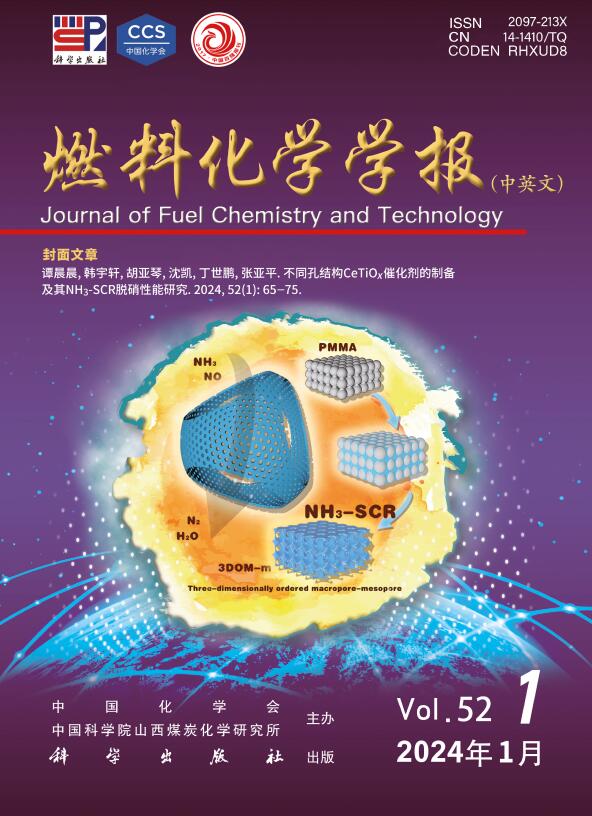Coal gasification fine slag and nitrogen-containing waste Co-hydrothermal preparation of porous materials for CO2 adsorption
Q3 Energy
引用次数: 0
Abstract
A new adsorbent was successfully prepared by hydrothermal treatment and chemical activation through coal gasification fine slag (CGFS) and blue algae (BA) as raw materials and used for CO2 capture. The CO2 chemisorption capacity of the adsorbent was further enhanced by taking advantage of the nitrogenous bases contained in the BA. In the hydrothermal process, the addition of BA significantly increased the content of pyrrole nitrogen in the adsorbent. In the activation process, pyrrole nitrogen gradually changed into pyridine nitrogen and graphite nitrogen. Increased BA addition result in a higher specific surface area and microporosity of the adsorbent. The CO2 adsorption performance test proved that the CGFS-50%-CA sample has the strongest CO2 adsorption capacity at low temperature, up to 15.59 cm3/g, which is mainly through physical adsorption, and the CGFS-10%-CA sample has the strongest CO2 adsorption capacity at high temperature, up to 7.31 cm3/g, which is mainly through chemical adsorption. CO2 uptake of the CGFS-10%-CA sample was well maintained after 10 cycles, with regeneration efficiencies above 99%. The results indicate that the novel adsorbents with coexistence of physical and chemical adsorption have great potential for CO2 adsorption applications.
煤气化细渣与含氮废渣共水热法制备吸附CO2的多孔材料
以煤气化细渣(CGFS)和蓝藻(BA)为原料,采用水热法和化学活化法制备了一种新型吸附剂,并将其用于CO2捕集。利用BA中所含的氮基,进一步提高了吸附剂对CO2的化学吸附能力。在水热过程中,BA的加入显著提高了吸附剂中吡咯氮的含量。在活化过程中,吡咯氮逐渐转化为吡啶氮和石墨氮。BA添加量的增加导致吸附剂的比表面积和微孔率的增加。CO2吸附性能测试证明,CGFS-50%-CA样品在低温下CO2吸附能力最强,可达15.59 cm3/g,主要通过物理吸附;CGFS-10%-CA样品在高温下CO2吸附能力最强,可达7.31 cm3/g,主要通过化学吸附。经过10次循环后,CGFS-10%-CA样品的CO2吸收率保持良好,再生效率在99%以上。结果表明,这种物理吸附和化学吸附共存的新型吸附剂具有很大的CO2吸附应用潜力。
本文章由计算机程序翻译,如有差异,请以英文原文为准。
求助全文
约1分钟内获得全文
求助全文
来源期刊

燃料化学学报
Chemical Engineering-Chemical Engineering (all)
CiteScore
2.80
自引率
0.00%
发文量
5825
期刊介绍:
Journal of Fuel Chemistry and Technology (Ranliao Huaxue Xuebao) is a Chinese Academy of Sciences(CAS) journal started in 1956, sponsored by the Chinese Chemical Society and the Institute of Coal Chemistry, Chinese Academy of Sciences(CAS). The journal is published bimonthly by Science Press in China and widely distributed in about 20 countries. Journal of Fuel Chemistry and Technology publishes reports of both basic and applied research in the chemistry and chemical engineering of many energy sources, including that involved in the nature, processing and utilization of coal, petroleum, oil shale, natural gas, biomass and synfuels, as well as related subjects of increasing interest such as C1 chemistry, pollutions control and new catalytic materials. Types of publications include original research articles, short communications, research notes and reviews. Both domestic and international contributors are welcome. Manuscripts written in Chinese or English will be accepted. Additional English titles, abstracts and key words should be included in Chinese manuscripts. All manuscripts are subject to critical review by the editorial committee, which is composed of about 10 foreign and 50 Chinese experts in fuel science. Journal of Fuel Chemistry and Technology has been a source of primary research work in fuel chemistry as a Chinese core scientific periodical.
 求助内容:
求助内容: 应助结果提醒方式:
应助结果提醒方式:


